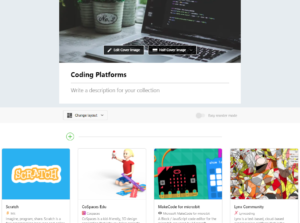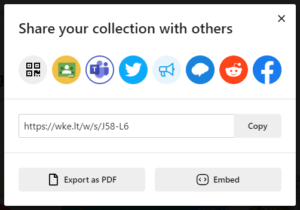This year more than ever, educators have relied on digital tools and resources to support their curricular programming. Whether you’re leading a virtual classroom or maintaining physical distance in a face-to-face context, there are countless activities and interactive tools available online that it can be difficult to keep track of them all. Enter Wakelet. Instead of spending hours organizing cluttered Bookmarks folders on your web browser, Wakelet is “a free platform that allows you to curate and organize content to save and share”. It’s like Pinterest, but for educators. You can save videos, articles, images, Tweets, links, other Wakelet collections, and more! And better yet, you can add your own text to better contextualize that resource for yourself or your students. And to make saving resources even easier, Wakelet has a Google Chrome Browser Extension so you can add content to your collections while you browse, never losing another awesome resource again!
Wakelet also provides educators with multiple ways to customize their collections. You  control the visibility of your content by making collections Public (anyone can access), Private (only you can access), or Unlisted (provide a link to those you wish to have access). You also control the appearance of your collections, adding header and background images (that you own, or select from Creative Commons databases built into Wakelet), and customizing the layout of each collection to fit the content. You can also invite others to contribute to a collaborative collection, consolidating all of your team’s resources into one place.
control the visibility of your content by making collections Public (anyone can access), Private (only you can access), or Unlisted (provide a link to those you wish to have access). You also control the appearance of your collections, adding header and background images (that you own, or select from Creative Commons databases built into Wakelet), and customizing the layout of each collection to fit the content. You can also invite others to contribute to a collaborative collection, consolidating all of your team’s resources into one place.
But Wakelet can do so much more than help you organize your resources. Here are a few ideas from the Wakelet Educator Handbook:
- Create Student Portfolios: Upload images of student work, files, formative assessment notes, and more to private collections for each student. This gives you an easy way to consolidate and evaluate progress at a glance! Note: To protect students’ privacy, be sure to remove any identifying details, mask students’ faces, etc. before uploading!
- Inquiry Learning Hubs: Consolidate resources and activity guidelines for inquiry-based student-driven learning into Wakelet collections for students to access as they need them. This provides choice and agency over students’ work processes.
- Digital Newsletter: Send guardians a snapshot of the things that are happening in your classroom with an easy Wakelet collection. Add photos, videos, text, links, and more to illustrate the concepts being learned, upcoming events, and opportunities for parents to get involved!
- Interactive Choice Boards: We have seen all sorts of amazing choice boards to facilitate student agency over learning, and Wakelet is another way to do just that. As in this example from Sean Fahey, Wakelet can be used to consolidate links, images, videos, and more into organized activities that students can choose between to demonstrate their learning.
And once you’ve created your collections, Wakelet makes it easy to share with your target  audience. Share your content directly to your Google Classroom or Microsoft Teams portal, on social media, with families using the Remind app, or anywhere you can think of using a link or QR code. Wakelet also provides HTML & JavaScript embed code that you can copy-and-paste directly into your classroom website. And while Wakelet is primarily a web-based application, you can also download the mobile versions for both Android and iOS.
audience. Share your content directly to your Google Classroom or Microsoft Teams portal, on social media, with families using the Remind app, or anywhere you can think of using a link or QR code. Wakelet also provides HTML & JavaScript embed code that you can copy-and-paste directly into your classroom website. And while Wakelet is primarily a web-based application, you can also download the mobile versions for both Android and iOS.
Want to see it in action? In honour of Digital Citizenship Week (October 19 – 23, 2020), check out these examples of Wakelets containing digital citizenship resources:
- Digital Citizenship Resources for Parents by Alfonso Mendoza
- Digital Citizenship Videos for 2nd – 5th Grade Students by Digital Citizenship
- Resources for Teaching Digital Citizenship by Amy Page
